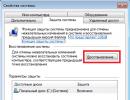Enter Windows 7 recovery mode. One of the reasons why system restore does not work
Has your computer or laptop started to glitch badly? Or does it not turn on at all? First of all, try restoring the Windows 7 OS system. The operation takes 10-15 minutes, but it can really help. Indeed, in this case, the Windows 7 system is rolled back to a couple of days ago, when the PC or laptop was still working perfectly.
This is an operation during which all settings and system files are restored from a backup created by Windows. That is, if you accidentally deleted important files or changed settings (for example, installed a new driver), and after that the computer began to slow down (or did not turn on at all), then this can be corrected. It's at least worth a try.
Restoring to a previous version of Windows is carried out using checkpoints that are created every week, as well as after making any changes (installing or removing programs). Typically, this feature is enabled automatically. Plus you can create control points manually.
There are at least 3 ways:
- Windows means;
- via safe mode;
- using a flash drive with Windows 7.
Let's look at each of them in more detail.
When you downgrade Windows 7, all your personal files will remain in place. Therefore, you don’t have to worry about this.
But there is one nuance here. When restoring, files recorded between today and the day you decide to roll back to may be lost. Therefore, if you recently (today, yesterday, the day before yesterday, etc.) downloaded important documents onto your PC, it is better to save them to a flash drive. Just in case.
How to return the system back using Windows 7?
The first way to roll back Windows 7 is through the OS itself. But it is only suitable if your PC or laptop turns on. It doesn’t matter if it glitches or freezes, the main thing is that you can load the desktop.
So, do the following:
After this, the Windows 7 system rollback will begin. When the operation is completed, the computer or laptop will reboot and you will see a message that everything was successful.
If this doesn't help, try enabling Windows 7 recovery by selecting a different checkpoint. But in this case, you will need to check the “Select another point” checkbox and click “Next”. And after that, the familiar window from step 4 will open.

Restoring the OS through Safe Mode
If your PC or laptop does not turn on at all, then you can try restoring Windows 7 startup in safe mode. To do this, when turning on (or restarting) the PC, press the F8 key repeatedly until the menu appears. Next, select “Safe Mode” and click Enter.
However, there are some nuances associated with different versions of Windows. Therefore, to avoid any difficulties, I recommend that you read –?
You wait until the computer or laptop turns on, and after that you perform all the same steps as in the previous option. That is, to roll back the Windows 7 system, follow steps 1 to 7 described above.
And the third method: recovery from a flash drive (or disk) with installation files
The disadvantage of this option is that you need to write it to a Windows flash drive, which is on your computer or laptop. And the plus is that in this way you can try to return the Windows 7 system, even when the PC does not turn on and safe mode does not start. That is, this is your last chance.
If you did everything correctly, the Windows 7 installation window will open.


Wait until the procedure is completed and click on “Reboot”. Then immediately remove the flash drive from the connector (or the disk from the drive), after which the PC should turn on in the usual way.
By the way, restoring Windows on a laptop and computer is the same. So you can try any method you choose.
That's all. Now you know how to roll back a Windows 7 system. I hope one of the 3 methods will work and you will be able to restore the functionality of your PC or laptop.
Oct 13 2013
How to perform a Windows 7 system recovery quickly and without nerves
How to perform a Windows 7 system recovery if your computer is unstable, the operating system does not load at all, or there is simply a black screen. See the video tutorial on how to run System Restore at the end of the article.
You have the Windows 7 operating system installed, then in this article you will learn different ways to restore system 7. In the previous publication, we learned what there are.
Launching Windows Recovery
Surely you or someone you know has encountered cases when Windows does not boot, or errors occur during the system. One way to fix this is to use Windows 7 System Restore.
Of course, there are other options for solving the problem, such as: safe mode, useful F8, system restore, installing or reinstalling Windows and others.
The recovery procedure or System Restore can be done in three different ways:
- Restoring using Windows itself
- Recovering via Safe Mode
- Restoring using the Windows 7 installation disc
System Restore using Windows
In order to begin restoring the Windows 7 system, you first need to figure out what errors are occurring and whether the operating system boots at all. If it boots, you can try to restore it from Windows.
Go to the desktop, find the shortcut or icon Computer (My Computer), right-click on it and go to Properties.

In the window for viewing basic information about your computer, go to the System Protection tab.

In System Properties, find the System Protection tab and click Recovery.

We get to Restore system files and settings, click Next.

Select the desired date with a recovery checkpoint. You can click the Show other recovery points checkbox if the one you need is not among the points presented. Click Next.

We confirm the restoration, indicate the system drives that we want to restore, and then continue.

We confirm the restore point, look again at its description and if everything is correct, click Finish. There is also the option of creating a password reset floppy disk. You can save this information to either a floppy disk or a USB flash memory device.

You may need it if you forget or lose your computer password. If you still forgot it, then here you go.
System Restore will not be able to be interrupted once it is running. Continue? Click Yes.

After this, the system prepares for its recovery, all open programs and applications are closed, and the computer reboots. The next time you start Windows 7, if everything went well, the following System Restore was successful window appears.

This is how system 7 recovery is done using standard Windows tools.
But let’s say that your Windows 7 operating system does not turn on and does not boot, how then can you perform a recovery? To do this, we will use the second method of restoring the Windows 7 system.
System Restore via Safe Mode
A window for additional boot options appears, select any safe mode and press Enter (Enter = Select).

Right-click on My Computer and go to Properties. The screen should be black, as shown in the screenshot.

Then go to Control Panel - Home Page.

Find and go to the Recovery tab (Restore the system to an earlier state).

To restore the previously saved state of this computer, click on the Start system recovery button. You can also select Advanced recovery methods.

After this, the Restore files and settings window appears.


Selecting a checkpoint >>> Confirming disk recovery >>> Confirming a recovery point >>> Starting the recovery procedure.

If the second method of system recovery did not help you, then the third option remains - we restore the computer with the Windows 7 installation disk.
Recovery using the Windows 7 installation disc
Let's look at how to restore Windows 7 using an installation disk.
If nothing helps you, then do it, look for information on the Internet, call a computer technician at home, contact a computer repair service center, or ask your question in the comments to this article.
Let's sum it up
Today we learned a lot of useful information on how to restore a Windows 7 system in three ways: restoring using Windows, restoring through safe mode, and using the Windows 7 installation disc.
Now let's watch a video tutorial on how to run System Restore.
How to do a system restore on Windows 7 | website
You may have questions related to restoring your computer system. You can ask them below in the comments to this article, and also use the form with me.
Thank you for reading me on
Unfortunately, there are many reasons for this problem, ranging from incorrectly written drivers, harmful effects of a virus, file system errors and ending with our erroneous actions when working with a computer. There is no need to be afraid of such problems, you need to learn how to deal with them effectively.
Let's think how to restore windows 7 system, and we will also insure ourselves in the future against possible troubles using backup and recovery tools built into the operating system. We will learn how to restore Windows 7, without using third-party backup programs, even when the System Recovery Options and button do not load F-8 will turn out to be useless.
Windows 7 has quite a powerful and good tool in its arsenal -> Recovery environment, which is created automatically during installation Windows 7 in a hidden section and contains five other tools that solve numerous malfunctions and problems. You can launch the recovery tool by pressing the F-8 button on the keyboard immediately after starting the computer. After this, a menu will open in front of you: Additional boot options: Troubleshoot your computer, then Safe Mode, Safe Mode with loading network drivers, etc.
Let's choose the first one-> Troubleshooting your computer,

Necessary digression: When installing Windows 7 Professional and Windows 7 Ultimate, a recovery environment partition is created automatically and is located in the root of the drive (C:) in the Recovery folder. You can also see in the Disk Management window - a separate, hidden partition of the hard drive, its volume is only 100 MB, it is used to store boot configuration files (BCD) and the system bootloader (bootmgr file). You can see it under Computer->Management->Disk Management. Under no circumstances should you delete this partition, otherwise you simply will not boot the system.

What should you do if you do not have a partition with a recovery environment and when you press the F-8 button in the Additional boot options menu, the Troubleshooting computer option does not appear? How then to restore the Windows 7 system?? An installation disk with the Windows 7 operating system can help here. You can run the recovery tool by booting from the original Windows 7 installation disk by selecting the item at the very beginning System Restore,


Note: In the screenshot you can see another hidden partition with a capacity of 9.02 GB, this is a hidden recovery partition with factory settings on my laptop, yours may be larger or smaller. It’s also better not to delete it; if necessary, you can always restore Windows 7 from it.

So, in the System Restore Selection menu, we select the first one:
Startup recovery-> there will be an analysis of faults that interfere with the normal loading of Windows 7 and their further correction for the normal loading and functioning of the operating system. During the process, we may be warned that problems have been detected in the boot parameters, click Fix and restart.








What's good about it? It will help when you don't have the original Windows 7 installation disk and you've deleted the hidden partition with your laptop's factory settings, but that's not all.
Sometimes there are situations when, for various reasons or due to the actions of a virus, you will not be able to load the operating system at all, or many people ask How to restore Windows 7 system even if the menu with Additional boot options is also unavailable. Should I reinstall the operating system again?
Therefore, immediately after installing Windows 7 on your laptop or computer, we create using this function-> Restoring a system image, an archived image of our Windows 7 on the hard drive, we take care of it. You must create a Windows 7 Recovery Disk (read below), it will help you use the System Image if the Advanced Boot Options menu does not load.
Let's go to Start->Control Panel->Archiving computer data.

Choose Creating a system image
Next, select Local disk, on which we will store the system archive. In my case, Local disk (E:), if you have several hard drives in the system unit, then of course it is better to place the backup on the hard drive where the operating system is not installed.

Click Archive and the process of creating an archive with our Windows 7 will begin.
Created, it will look like this.

Now, if necessary, you can deploy the archive with Windows 7 to your computer in 20-30 minutes. It would be better if you additionally copy the archive with the system onto a portable hard drive, this will doubly protect you. Let's imagine that we can't start Windows 7 and deploy the backup we created, let's do it together.
Let's launch Windows 7 Recovery Tool, by pressing a button F-8 on the keyboard immediately after starting the computer. The Advanced boot options menu opens, select Troubleshoot your computer.






Of course, all our data on the Local Disk, where the operating system is now being restored, will be deleted, so you can first boot from any Live CD and copy what you need.
How else can you restore your Windows 7 system? Of course, using the Windows 7 Recovery Disk. Let's create Recovery disk, which can be used to boot the computer, it will contain recovery tools that can be used to repair Windows 7 boot problems, as well as restore the operating system from the backup copy that we created in advance.
Important: The bitness of the system is important for the recovery disk, you can use a 32-bit recovery disk for any 32-bit Windows 7, and a 64-bit recovery disk for any 64-bit Windows 7.
Let's go again Backing up computer data



When the bootable Windows 7 Recovery Disk is ready, put it in a safe place. To restore Windows 7 from the Recovery Disk, you basically don’t need any working operating system at all. You will only need to change the boot priority to the drive in the BIOS of your computer, insert the recovery disk into it and restore your Windows 7 using the archive. Many here can draw an analogy with data backup programs and this is correct, they work on the same principle, only Of course, their functionality is more convenient.
Greetings to all readers of the blog site. Today I will tell you how to restore a Windows 7 system. If we encounter a certain problem with a PC, for example, its operating speed has deteriorated significantly, or some applications do not start, then, first of all, we need to try to roll back the operating system, which is an excellent alternative. This way we will return the original setup data and system files from the “backup”.
This is an excellent opportunity to instantly repair your PC and ensure its high-quality operation. This article will provide several ways to roll back Windows 7.
- How to rollback directly from under the system.
- Restore the OS using safe mode.
The first method is useful when the PC turns on and functions, with or without glitches, the main thing is that it works. For example, either the driver has problems. You completely leveled the product, but the computer didn’t work any better. In this case, a rollback would be a good solution to the problem.
So, go to the start menu and write the word “Recovery” in the search bar. In the displayed window, find the standard Windows System Restore program.

Then you need to select a recovery point, from which, in fact, the rollback will occur. Click “Next”.

Click "Done".

Here you will encounter another warning - click “Yes”.

A window will appear with the preparation process, after which the PC will reboot and you will see a message with the text: “OS recovery completed successfully.”

If this does not bring any results, then try to roll back to another point.
How to restore Windows 7 using Safe Mode.
You can also roll back configuration data and files using this mode when, for example, the OS does not want to boot normally. This method has repeatedly helped many users.
First you need to boot the system in safe mode (after turning on the PC, periodically press the F8 key and select the appropriate item).

You must wait until the computer finishes loading. In the future, we perform all operations similarly to the first method.

Since I recently performed an OS rollback, I saw an option with the option to disable the recovery process. Find the item “Select another point...” and click on the “Next” button.

We find the required point for rollback and click “Next”.

Click “Finish”.

We respond to the new warning by clicking “Yes”. The PC will reboot and will begin to work in normal mode.
That's all for me! I hope you now know how to restore a Windows 7 system. If you have any questions for me, be sure to ask them in the comments. I will also not refuse warm words in my direction) I wish good health to all my readers and just guests!
With UV. Evgeny Kryzhanovsky
All owners of desktop computers or laptops, sooner or later have to reinstall the OS, be it Windows 7 or any other modification. There are many reasons for damage to the operating system (malware infection, incorrect installation of drivers, accidental deletion of system data, etc.). However, if information that is important to you is saved in the system partition of the PC (for example, on the desktop), after the demolition of the operating system it will also be deleted. To prevent this, you can restore Windows instead of reinstalling.
Ways to restore Windows 7 without reinstalling
The developers of this operating system took care of its reliability, equipping the product with many protective functions, among which the most useful is the recovery procedure. This software tool allows you to restore the functionality of the OS without completely reinstalling it.
There are several ways to initiate the Windows reanimation process:
- using last known known configuration;
- using the program;
- via a restore point;
- via BISO.
To complete the task, you do not have to look for any software or use additional devices.
The only thing you need to prepare is a DVD with Windows 7 OS of the exact build that was installed on your computer. The ideal option is to use the same disk.
Restoring the last good configuration
Every time you exit the system, all the important data necessary for the launch and operation of the operating system is entered into the registry. It is this information that the recovery procedure uses.
To activate it you need:
If after completing the above steps the system boots, it is recommended that all important information saved in the system partition (“My Documents”, drive C, desktop) be copied to another drive. After this, check your PC for malware and, if possible, perform a full system diagnostic.
Using this recovery procedure, you will not be able to recover lost personal data (music, videos, etc.), since it only works with system files. To restore such information, you need to use additional programs.
Restoring Windows using the Chkdsk application
Chkdsk (from the English “check disk”) is a program built into the operating system that searches for damaged system files on the hard drive and restores them.
Another useful property of this tool is diagnosing storage media for mechanical damage to sectors and blocking access to them, thereby speeding up the operation of the system.
There are two ways to initialize Chkdsk:
- via graphical interface;
- from the command line.
In the first case it is necessary:

To run Chkdsk from the command line:

After this, the Windows system will restart and be diagnosed for damage.
Applying a restore point
A restore point is an OS element that stores a copy of system files, drivers and installed programs recorded at a certain time. In Windows, such points are created automatically at regular intervals, as well as after installing and updating programs.
To use a restore point, you need to:

Restoring a Windows system via BIOS
If it is impossible to start the OS, restoring using the methods described above will not work. In this case, you can use the BIOS to resuscitate Windows without reinstalling it.
The procedure will be as follows:






